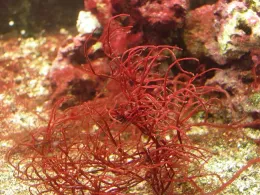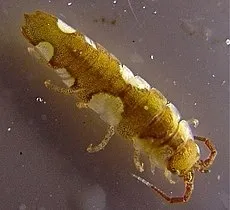Birds do it, bees do it,
Even seaweeds in the seas do it…with apologies to Cole Porter

In the new paper, Lavaut et al present convincing evidence that Gracilaria gracilis, a red seaweed, is pollinated by a marine isopod crustacean, Idotea balthica (think underwater sowbugs) [3]. Gracilaria gracilis belongs to the class Florideophyceae. Unlike other seaweeds, the male gametes of species in this group of seaweeds lack mobile tails (flagella), and so cannot transport themselves, making animal-mediated pollination a particularly important innovation. Idotea carries the male gametes (spermatia) on their bodies and transports these gametes to the female receptacles (trichogyne) on a female thallus, where fertilization takes places [3].
In experiments Lavaut et al demonstrated that fertilization of the trichogyne was twenty times more successful in aquaria with Idotea than without. In fact, fertilization in still-water aquaria without Idotea was negligible—demonstrating that, like birds and bees, Idotea balthica acts as a pollinator for Gracilaria gracilis [3].

Like birds and bees, Idotea balthica's role as a pollinator is the indirect result of its foraging and other activities. Idotea balthica seeks refuge from fish predators in patches of Gracilaria gracilis where it also forages on epiphytic algae that grow on the seaweed's fronds [4]–[6].
Gracilaria gracilis and other seaweeds are not plants. Although they photosynthesize, seaweeds are a type of algae and only distantly related to plants. The Florideophyceae are thought to have arisen as much as a billion years ago [7]. Animal-mediated pollination in the Florideophyceae suggests that pollination could have originated long before the origin of flowering plants [8].
The isopods are not as old as the Florideophyceae. They are thought to have existed for about 300 million years—what pollinated seaweeds in the Florideophyceae before the isopods [9]? The seaweeds may have relied upon other extinct invertebrates as pollinators. The earliest arthropods only appear about 600 million years ago [9]. How these seaweeds were reproducing before arthropods arrived on the scene is unknown. They may have relied on water currents until potential pollinators appeared and Gracilaria gracilis likely uses water currents as well as invertebrate pollinators, like terrestrial plants that take advantage of wind and animal pollination[9].
We know so little about the ecological relationships that shape our world. Estimates suggest that only 10% of the known animal-pollinated angiosperm species have had their pollinators documented [9]. Now we have a study that suggests animal pollination may have evolved before plants moved onto land. Did pollination exist before plants? Studies of animal mediated pollination in the sea are just beginning, so many discoveries await us.
Resources
[1] C. J. van der Kooi and J. Ollerton, “The origins of flowering plants and pollinators,” Science, vol. 368, no. 6497, pp. 1306–1308, Jun. 2020, doi: 10.1126/science.aay3662.
[2] J. Ollerton and E. Coulthard, “Evolution of Animal Pollination,” Science, vol. 326, no. 5954, pp. 808–809, Nov. 2009, doi: 10.1126/science.1181154.
[3] E. Lavaut et al., “Pollinators of the sea: A discovery of animal-mediated fertilization in seaweed,” Science, vol. 377, no. 6605, pp. 528–530, Jul. 2022, doi: 10.1126/science.abo6661.
[4] C. D. Amsler, J. B. McClintock, and B. J. Baker, “Chemical mediation of mutualistic interactions between macroalgae and mesograzers structure unique coastal communities along the western Antarctic Peninsula,” J. Phycol., vol. 50, no. 1, pp. 1–10, 2014, doi: 10.1111/jpy.12137.
[5] C. F. Aumack, C. D. Amsler, J. B. McClintock, and B. J. Baker, “Impacts of Mesograzers on Epiphyte and Endophyte Growth Associated with Chemically Defended Macroalge from the Western Antarctic Peninsula: A Mesocosm Experiment1,” J. Phycol., vol. 47, no. 1, pp. 36–41, 2011, doi: 10.1111/j.1529-8817.2010.00927.x.
[6] T. M. Bell and E. E. Sotka, “Local adaptation in adult feeding preference and juvenile performance in the generalist herbivore Idotea balthica,” Oecologia, vol. 170, no. 2, pp. 383–393, Oct. 2012, doi: 10.1007/s00442-012-2302-3.
[7] E. C. Yang et al., “Divergence time estimates and the evolution of major lineages in the florideophyte red algae,” Sci. Rep., vol. 6, no. 1, Art. no. 1, Feb. 2016, doi: 10.1038/srep21361.
[8] H. Sauquet, S. Ramírez-Barahona, and S. Magallón, “What is the age of flowering plants?,” J. Exp. Bot., vol. 73, no. 12, pp. 3840–3853, Jun. 2022, doi: 10.1093/jxb/erac130.
[9] J. Ollerton and Z.-X. Ren, “Did pollination exist before plants?,” Science, vol. 377, no. 6605, pp. 471–472, Jul. 2022, doi: 10.1126/science.add3198.
Image 1 Idotea balthica credit Mark Blaxter, Wikimedia commons https://commons.wikimedia.org/wiki/Category:Idotea_balthica#/media/File:Idotea_baltica.jpg
Image 2 Gracilaria sp. Credit Eric Moody Wikimedia commons https://commons.wikimedia.org/wiki/File:Gracilaria2.JPG

